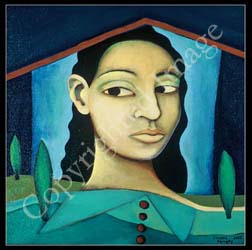Monday, July 25, 2005
Wednesday, March 30, 2005
Azowano ~ Asoji ~ Asohano
Azowano is just one of the many names given to Beloved Babaluaye.Babaluaye's Best Friend
He is also called: Agronica, Sagbata, Asoji, Afimaye, depending on his "camino" or incarnation.
He is the Great Orisha of the Araras, the people of Dahomey.
He is the Orisha of sickness and disease.
He is an Orisha that is very miraculous & can help with the cure of many diseases.
Even though he was a king in Dahomey, he is a very humble Orisha.
We are dedicating this site to him in hopes that you will grow to love this Orisha as we do.
Why is Babaluaye associated with dogs? This is one of the reasons that the Catholic Saint, San Lazaro, was chosen to represent him in his Christianized version. The image of San Lazaro contains dogs, and naturally he was chosen to represent Babaluaye. He was chosen also for the fact also that Lazarus rose from the dead, just as Babaluaye did. When Babaluaye had to leave the kingdom of the Yorubas (which is another story), he consulted Orunla and Orunla told him to take two dogs with him. Ogun and Ochossi gave him the dogs and they accompanied him on his journey through the rain forest. The dogs helped guide him on his journey to the land of the Araras, where he became King. (That, too, is another story). For that reason, it is recommended that when you see beggars on the street, accompanied by dogs that you give them something. It might be Babaluaye in desguise!
King of the World
Azowano is often called the King of the World. One of the reasons for that is that he is associated with the earth element. Legend has it that his mother died while she was carrying him and he was delivered from the mother's tomb. You can't get more associated with earth than that. He is also called, "King of the World" because of his ability to control that element. Due to this ability, he is able to give material blessings. So he is not only adored as an Orisha that is able to cure diseases, but also as one that can give prosperity. His astrological association is with the planet Saturn, and like Saturn, he is a stern taskmaster. Promises to him are NEVER to be broken. Broken promises to him can incur his wrath and that is not pleasant. However, if Babaluaye is treated with respect like the other Orishas, then you have nothing to worry about.
Dweller of the Rain Forest and Swamps
Azowano is known to dwell in the rain forests and swamps. He likes these places because they are places of life but also of decay and putrification. The old leaves dying on the forest floor give nutriments to the other trees and plants. Another, is the cycle of death and rebirth, just as he was buried in death and reborn from the earth. Most always the offerings that are given to Babaluaye are taken to the woods, after having been placed in front of him for the appropriate time. Sometimes, offerings are made to him at the entrance of the cemetery. He is an Orisha strongly connected with Death, due to the history of his birth, coming into the world resurrected from the dead. Babaluaye lives apart from the other Orishas, sometimes outside of the house. He does not like prying eyes to be upon him. His feast day in this part of the world is December 17th. Usually, one awaits him the night before (vispera) and at precisely midnight, his celebration begins. Often certain cleansings are performed at this hour to ensure health for the coming year.
St. Lazarus - San Lazaro

"Saint Lazarus"
- traditional Roman Catholic image

Feastday: June 21
Lazarus is the poor man at the gate of the rich man in Christ's parable related in Luke. (Luke 16:19-31) His name was perpetuated in the Middle Ages by such words as Lazaretto (hospital), Lazarone (a beggar in the street), and the Order of St. Lazarus, which though a military order, had as one of its objectives, the care of lepers. His feast day is June 21st.
LAZARUS: Also known as Lazaro
Memorial: 21 June
Profile
Leper mentioned by Christ in the parable of Lazarus and the rich man in the Gospel of Luke (see below).
The Order of Saint Lazarus was founded in the 12th century to provide nursing for lepers, taking Lazarus as its patron. The knights of the order were lepers, and besides helping their fellow sufferers, they carried out military duties. They founded a hospital for lepers near the northern wall of Jerusalem.
Patronage
lepers,
leprosy,
Order of Saint Lazarus
Additional Bible Story Translations:
français deutsch italiano português
JESUS, THE CHRIST » HISTORY OF » Enunciates the parable of the rich man and Lazarus (in Peraea) (Luke 16:19-31) (New International Version)
The Rich Man and Lazarus
19“There was a rich man who was dressed in purple and fine linen and lived in luxury every day. 20At his gate was laid a beggar named Lazarus, covered with sores 21and longing to eat what fell from the rich man's table. Even the dogs came and licked his sores.
22“The time came when the beggar died and the angels carried him to Abraham's side. The rich man also died and was buried. 23In hell,[a] where he was in torment, he looked up and saw Abraham far away, with Lazarus by his side. 24So he called to him, ‘Father Abraham, have pity on me and send Lazarus to dip the tip of his finger in water and cool my tongue, because I am in agony in this fire.’
25“But Abraham replied, ‘Son, remember that in your lifetime you received your good things, while Lazarus received bad things, but now he is comforted here and you are in agony. 26And besides all this, between us and you a great chasm has been fixed, so that those who want to go from here to you cannot, nor can anyone cross over from there to us.’
27“He answered, ‘Then I beg you, father, send Lazarus to my father's house, 28for I have five brothers. Let him warn them, so that they will not also come to this place of torment.’
29“Abraham replied, ‘They have Moses and the Prophets; let them listen to them.’
30“ ‘No, father Abraham,’ he said, ‘but if someone from the dead goes to them, they will repent.’
31“He said to him, ‘If they do not listen to Moses and the Prophets, they will not be convinced even if someone rises from the dead.’ ”
Footnotes:
a. Luke 16:23 Greek Hades
Lucas 16:19-31 (Nueva Versión Internacional)
19"Había un hombre rico que se vestía lujosamente* y daba espléndidos banquetes todos los días.
20A la puerta de su casa se tendía un mendigo llamado Lázaro, que estaba cubierto de llagas
21y que hubiera querido llenarse el estómago con lo que caía de la mesa del rico. Hasta los perros se acercaban y le lamían las llagas.
22"Resulta que murió el mendigo, y los ángeles se lo llevaron para que estuviera al lado de Abraham. También murió el rico, y lo sepultaron.
23En el infierno,* en medio de sus tormentos, el rico levantó los ojos y vio de lejos a Abraham, y a Lázaro junto a él.
24Así que alzó la voz y lo llamó: 'Padre Abraham, ten compasión de mí y manda a Lázaro que moje la punta del dedo en agua y me refresque la lengua, porque estoy sufriendo mucho en este fuego.'
25Pero Abraham le contestó: 'Hijo, recuerda que durante tu vida te fue muy bien, mientras que a Lázaro le fue muy mal; pero ahora a él le toca recibir consuelo aquí, y a ti, sufrir terriblemente.
26Además de eso, hay un gran abismo entre nosotros y ustedes, de modo que los que quieren pasar de aquí para allá no pueden, ni tampoco pueden los de allá para acá.'
27"Él respondió: Éntonces te ruego, padre, que mandes a Lázaro a la casa de mi padre,
28para que advierta a mis cinco hermanos y no vengan ellos también a este lugar de tormento.'
29Pero Abraham le contestó: 'Ya tienen a Moisés y a los profetas; ¡que les hagan caso a ellos!'
30'No les harán caso, padre Abraham --replicó el rico--; en cambio, si se les presentara uno de entre los muertos, entonces sí se arrepentirían.'
31Abraham le dijo: 'Si no les hacen caso a Moisés y a los profetas, tampoco se convencerán aunque alguien se levante de entre los muertos.' "
http://stlazarus.info.tripod.com/parable.html
The Military and Hospitaller
Order of
Saint Lazarus of Jerusalem
International
Our New Zealand Grand Priory
The Parable of Saint Lazarus, Luke - Chapter 16
This is placed here to hopefully avoid confusion:
Please note that the Order of St. Lazarus has Lazarus as their patron saint. However, there is a bit of controversy as to whether the "historical" Lazarus, brother of Mary and Martha of Bethany, who was raised from the dead, in the 1st century, by Christ, was a leper, like the Lazarus in the Parable above. The Order of Saint Lazarus celebrates their feast day on December 17th. Lazarus of John 11:1 and 11:5 was the younger brother of Martha and Mary of Bethany.
It is assumed, by Biblical scholars, that both men named Lazarus were leperous, since the name has this connotation (as expressed above). The Lazarus that Christ raised from the dead, was said to have traveled to Marseilles (with his famous sisters), after Christ's Ascension, and was the first bishop of that city. (Kelly, Sean & Rosemary Rodgers. Saints Preserve Us. New York: Random House, 1993.Kelly, Sean & Rosemary Rodgers. The Birthday Book of Saints: Your Powerful Personal Patrons for Every Blessed Day of the Year. New York: Villard Books, a div. of Random House, 2002)
Be advised that I have twenty-five(25) "Saint Books" in my library and they are basically undecided on this issue. Many books list them as two separate men with two separate feast days, thus the date stated above this box is for the Lazarus of the Parable. Respectively submitted. 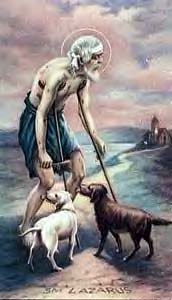
Saint Lazarus 
http://www.corazones.org/santos/lazaro%20.htm
San Lázaro
Etim: "Dios ayuda"
Fiesta: 17 de diciembre
San Lázaro y sus dos hermanas, María (la que ungió al Señor con perfume y le secó los pies con sus cabellos) y Marta, eran amigos de Jesús y le invitaban a su casa en Betania, cerca de Jerusalén. En aquel hogar Jesús era amado y visitaba cuando estaba en Jerusalén.
Jesús resucitó a Lázaro. Ver: Juan 11,1-44.
Ya en el siglo III se le veneraba en toda la Iglesia. La peregrina a Jerusalén, Eteria (c.390), describe impresionada sobre la gran procesión que se hacía el sábado anterior al Domingo de Ramos al "Lazarium" (sitio en el que Lázaro había sido resucitado.
No sabemos de su vida posterior pero hay muchas tradiciones. En las Pseudo-Clementinas se cuenta que Lázaro acompañó a San Pedro a Siria. La tradición más común en el oriente afirma que los judíos embarcaron a Lázaro en Jaffa en una nave que hacía agua, junto con sus dos hermanas y otros cristianos, y la nave llegó milagrosamente a la isla de Chipre. Lázaro fue, según esa tradición, elegido obispo de Kition (Larnaka), y murió 30 años después.
El año 890, el emperador León VI construyó una iglesia y un monasterio en su honor en Constantinopla y trasladó allá una parte de las pretendidas reliquias, que se hallaban en Chipre.
En el siglo XI, en relación de la leyenda provenzal de Santa María Magdalena, empezó a decirse que Lázaro había sido obispo de Provenza y había muerto mártir en Francia. El Papa Benedicto IX, en ocasión de la consagración de la iglesia de San Víctor de Marsella, hace alusión a las reliquias de Lázaro que estaban ahí.
Hay otro Lázaro en el Evangelio:
El pobre ilustrado en la parábola de Jesus (Cf. Lc 16,20-25), el cual es representado popularmente con perros y muleta. Este NO es un personaje histórico sino parte de una parábola de Jesús. Por lo tanto NO es un santo.
Ver también milagros
-Adaptado de la Vida de los Santos de Butler. San Lázaro
JESUS, THE CHRIST » HISTORY OF »
Returns to Bethany and raises Lazarus from the dead ( John 11:1-46)
Juan 11:1-46 (Nueva Versión Internacional)
1Había un hombre enfermo llamado Lázaro, que era de Betania, el pueblo de María y Marta, sus hermanas.
2María era la misma que ungió con perfume al Señor, y le secó los pies con sus cabellos.
3Las dos hermanas mandaron a decirle a Jesús: "Señor, tu amigo querido está enfermo."
4Cuando Jesús oyó esto, dijo: "Esta enfermedad no terminará en muerte, sino que es para la gloria de Dios, para que por ella el Hijo de Dios sea glorificado."
5Jesús amaba a Marta, a su hermana y a Lázaro.
6A pesar de eso, cuando oyó que Lázaro estaba enfermo, se quedó dos días más donde se encontraba.
7Después dijo a sus discípulos: --Volvamos a Judea.
8--Rabí --objetaron ellos--, hace muy poco los judíos intentaron apedrearte, ¿y todavía quieres volver allá?
9--¿Acaso el día no tiene doce horas? --respondió Jesús--. El que anda de día no tropieza, porque tiene la luz de este mundo.
10Pero el que anda de noche sí tropieza, porque no tiene luz.
11Dicho esto, añadió: --Nuestro amigo Lázaro duerme, pero voy a despertarlo.
12--Señor --respondieron sus discípulos--, si duerme, es que va a recuperarse.
13Jesús les hablaba de la muerte de Lázaro, pero sus discípulos pensaron que se refería al sueño natural.
14Por eso les dijo claramente: --Lázaro ha muerto,
15y por causa de ustedes me alegro de no haber estado allí, para que crean. Pero vamos a verlo.
16Entonces Tomás, apodado el Gemelo,* dijo a los otros discípulos: --Vayamos también nosotros, para morir con él.
17A su llegada, Jesús se encontró con que Lázaro llevaba ya cuatro días en el sepulcro.
18Betania estaba cerca de Jerusalén, como a tres kilómetros* de distancia,
19y muchos judíos habían ido a casa de Marta y de María, a darles el pésame por la muerte de su hermano.
20Cuando Marta supo que Jesús llegaba, fue a su encuentro; pero María se quedó en la casa.
21--Señor --le dijo Marta a Jesús--, si hubieras estado aquí, mi hermano no habría muerto.
22Pero yo sé que aun ahora Dios te dará todo lo que le pidas.
23--Tu hermano resucitará --le dijo Jesús.
24--Yo sé que resucitará en la resurrección, en el día final --respondió Marta.
25--Yo soy la resurrección y la vida. El que cree en mí vivirá, aunque muera;
26y todo el que vive y cree en mí no morirá jamás. ¿Crees esto?
27--Sí, Señor; yo creo que tú eres el Cristo, el Hijo de Dios, el que había de venir al mundo.
28Dicho esto, Marta regresó a la casa y, llamando a su hermana María, le dijo en privado: --El Maestro está aquí y te llama.
29Cuando María oyó esto, se levantó rápidamente y fue a su encuentro.
30Jesús aún no había entrado en el pueblo, sino que todavía estaba en el lugar donde Marta se había encontrado con él.
31Los judíos que habían estado con María en la casa, dándole el pésame, al ver que se había levantado y había salido de prisa, la siguieron, pensando que iba al sepulcro a llorar.
32Cuando María llegó a donde estaba Jesús y lo vio, se arrojó a sus pies y le dijo: --Señor, si hubieras estado aquí, mi hermano no habría muerto.
33Al ver llorar a María y a los judíos que la habían acompañado, Jesús se turbó y se conmovió profundamente.
34--¿Dónde lo han puesto? --preguntó. --Ven a verlo, Señor --le respondieron.
35Jesús lloró.
36--¡Miren cuánto lo quería! --dijeron los judíos.
37Pero algunos de ellos comentaban: --Éste, que le abrió los ojos al ciego, ¿no podría haber impedido que Lázaro muriera?
38Conmovido una vez más, Jesús se acercó al sepulcro. Era una cueva cuya entrada estaba tapada con una piedra.
39--Quiten la piedra --ordenó Jesús. --Señor --objetó Marta, la hermana del muerto--, que ya debe oler mal, pues lleva cuatro días allí.
40--¿No te dije que si crees verás la gloria de Dios? --le contestó Jesús.
41Entonces quitaron la piedra. Jesús, alzando la vista, dijo: --Padre, te doy gracias porque me has escuchado.
42Ya sabía yo que siempre me escuchas, pero lo dije por la gente que está aquí presente, para que crean que tú me enviaste.
43Dicho esto, gritó con todas sus fuerzas: --¡Lázaro, sal fuera!
44El muerto salió, con vendas en las manos y en los pies, y el rostro cubierto con un sudario. --Quítenle las vendas y dejen que se vaya --les dijo Jesús.
45Muchos de los judíos que visitaban a María y que habían presenciado lo hecho por Jesús, creyeron en él.
46Pero algunos de ellos fueron a ver a los fariseos y les contaron lo que Jesús había hecho.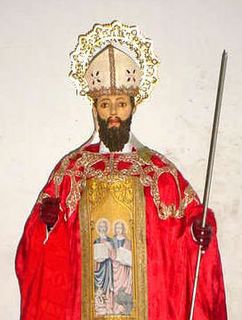
San Lazaro 
John 11:1-46 (New International Version)
The Death of Lazarus
1Now a man named Lazarus was sick. He was from Bethany, the village of Mary and her sister Martha. 2This Mary, whose brother Lazarus now lay sick, was the same one who poured perfume on the Lord and wiped his feet with her hair. 3So the sisters sent word to Jesus, “Lord, the one you love is sick.”
4When he heard this, Jesus said, “This sickness will not end in death. No, it is for God's glory so that God's Son may be glorified through it.” 5Jesus loved Martha and her sister and Lazarus. 6Yet when he heard that Lazarus was sick, he stayed where he was two more days.
7Then he said to his disciples, “Let us go back to Judea.”
8“But Rabbi,” they said, “a short while ago the Jews tried to stone you, and yet you are going back there?”
9Jesus answered, “Are there not twelve hours of daylight? A man who walks by day will not stumble, for he sees by this world's light. 10It is when he walks by night that he stumbles, for he has no light.”
11After he had said this, he went on to tell them, “Our friend Lazarus has fallen asleep; but I am going there to wake him up.”
12His disciples replied, “Lord, if he sleeps, he will get better.” 13Jesus had been speaking of his death, but his disciples thought he meant natural sleep.
14So then he told them plainly, “Lazarus is dead, 15and for your sake I am glad I was not there, so that you may believe. But let us go to him.”
16Then Thomas (called Didymus) said to the rest of the disciples, “Let us also go, that we may die with him.”
Jesus Comforts the Sisters
17On his arrival, Jesus found that Lazarus had already been in the tomb for four days. 18Bethany was less than two miles[a] from Jerusalem, 19and many Jews had come to Martha and Mary to comfort them in the loss of their brother. 20When Martha heard that Jesus was coming, she went out to meet him, but Mary stayed at home.
21“Lord,” Martha said to Jesus, “if you had been here, my brother would not have died. 22But I know that even now God will give you whatever you ask.”
23Jesus said to her, “Your brother will rise again.”
24Martha answered, “I know he will rise again in the resurrection at the last day.”
25Jesus said to her, “I am the resurrection and the life. He who believes in me will live, even though he dies; 26and whoever lives and believes in me will never die. Do you believe this?”
27“Yes, Lord,” she told him, “I believe that you are the Christ,[b] the Son of God, who was to come into the world.”
28And after she had said this, she went back and called her sister Mary aside. “The Teacher is here,” she said, “and is asking for you.” 29When Mary heard this, she got up quickly and went to him. 30Now Jesus had not yet entered the village, but was still at the place where Martha had met him. 31When the Jews who had been with Mary in the house, comforting her, noticed how quickly she got up and went out, they followed her, supposing she was going to the tomb to mourn there.
32When Mary reached the place where Jesus was and saw him, she fell at his feet and said, “Lord, if you had been here, my brother would not have died.”
33When Jesus saw her weeping, and the Jews who had come along with her also weeping, he was deeply moved in spirit and troubled. 34“Where have you laid him?” he asked.
“Come and see, Lord,” they replied.
35Jesus wept.
36Then the Jews said, “See how he loved him!”
37But some of them said, “Could not he who opened the eyes of the blind man have kept this man from dying?”
Jesus Raises Lazarus From the Dead
38Jesus, once more deeply moved, came to the tomb. It was a cave with a stone laid across the entrance. 39“Take away the stone,” he said.
“But, Lord,” said Martha, the sister of the dead man, “by this time there is a bad odor, for he has been there four days.”
40Then Jesus said, “Did I not tell you that if you believed, you would see the glory of God?”
41So they took away the stone. Then Jesus looked up and said, “Father, I thank you that you have heard me. 42I knew that you always hear me, but I said this for the benefit of the people standing here, that they may believe that you sent me.”
43When he had said this, Jesus called in a loud voice, “Lazarus, come out!” 44The dead man came out, his hands and feet wrapped with strips of linen, and a cloth around his face.
Jesus said to them, “Take off the grave clothes and let him go.”
The Plot to Kill Jesus
45Therefore many of the Jews who had come to visit Mary, and had seen what Jesus did, put their faith in him. 46But some of them went to the Pharisees and told them what Jesus had done.
Footnotes:
a. John 11:18 Greek fifteen stadia (about 3 kilometers)
b. John 11:27 Or Messiah
http://www.newadvent.org/cathen/09096a.htm
Lazarus
Lazarus (Gk. Lazaros, a contraction of Eleazaros--see II Mach., vi, 18--meaning in Hebrew "God hath helped"), the name of two persons in the N.T.; a character in one of Christ's parables, and the brother of Martha and Mary of Bethania.
I. LAZARUS OF THE PARABLE
(1) The Story
The dramatic story of the rich man and the beggar (only in Luke, xvi, 19-31) is set forth by Christ in two striking scenes:
Their Condition Here: The rich man was clothed in purple and byssus (D.V. fine linen), and spent each day in gay carousing. The beggar had been cast helpless at the rich man's gate, and lay there all covered with sores; he yearned for the crumbs that fell from the rich man's table, but received none, and was left to the dogs.
Their Condition Hereafter: The early banquet is over; the heavenly banquet is begun. Lazarus partakes of the banquet in a place of honour (cf. John, xiii, 23). He reclines his head on Abraham's bosom. The rich man is now the outcast. He yearns for a drop of water. Lazarus is not allowed to leave the heavenly banquet and tend to the outcast.
(2) The Meaning
Catholic exegetes now commonly accept the story as a parable. It is also legendary that the sores of Lazarus were leprous. The purpose of the parable is to teach us the evil result of the unwise neglect of one's opportunities. Lazarus was rewarded, not because he was poor, but for his virtuous acceptance of poverty; the rich man was punished, not because he was rich, but for vicious neglect of the opportunities given him by his wealth.
II. LAZARUS OF THE MIRACLE
This personage was the brother of Martha and Mary of Bethania; all three were beloved friends of Jesus (John, xi, 5). At the request of the two sisters Jesus raised Lazarus from the dead (John, xi, 41-44). Soon thereafter, the Saturday before Palm Sunday, Lazarus took part in the banquet which Simon the Leper gave to Jesus in Bethania (Matt., xxvi, 6-16; Mark, xiv, 3-11; John, xii, 1-11). Many of the Jews believed in Jesus because of Lazarus, whom the chief priests now sought to put to death. The Gospels tell us no more of Lazarus (see ST. LAZARUS OF BETHANY).
http://www.newadvent.org/cathen/09097a.htm
St. Lazarus of Bethany
Reputed first Bishop of Marseilles, died in the second half of the first century. According to a tradition, or rather a series of traditions combined at different epochs, the members of the family at Bethany, the friends of Christ, together with some holy women and others of His disciples, were put out to sea by the Jews hostile to Christianity in a vessel without sails, oars, or helm, and after a miraculous voyage landed in Provence at a place called today the Saintes-Maries. It is related that they separated there to go and preach the Gospel in different parts of the southeast of Gaul. Lazarus of whom alone we have to treat here, went to Marseilles, and, having converted a number of its inhabitants to Christianity, became their first pastor. During the first persecution under Nero he hid himself in a crypt, over which the celebrated Abbey of St.-Victor was constructed in the fifth century. In this same crypt he was interred, when he shed his blood for the faith. During the new persecution of Domitian he was cast into prison and beheaded in a spot which is believed to be identical with a cave beneath the prison Saint-Lazare. His body was later translated to Autun, and buried in the cathedral of that town. But the inhabitants of Marseilles claim to be in possession of his head which they still venerate. Like the other legends concerning the saints of the Palestinian group, this tradition, which was believed for several centuries and which still finds some advocates, has no solid foundation. It is in a writing, contained in an eleventh century manuscript, with some other documents relating to St. Magdalen of Vézelay, that we first read of Lazarus in connection with the voyage that brought Magdalen to Gaul. Before the middle of the eleventh century there does not seem to be the slightest trace of the tradition according to which the Palestinian saints came to Provence. At the beginning of the twelfth century, perhaps through a confusion of names, it was believed at Autun that the tomb of St. Lazarus was to be found in the cathedral dedicated to st. Nazarius. A search was made and remains were discovered, which were solemnly translated and were considered to be those of him whom Christ raised from the dead, but it was not thought necessary to inquire why they should be found in France.
The question, however, deserved to be examined with care, seeing that, according to a tradition of the Greek Church, the body of St. Lazarus had been brought to Constantinople, just as all the other saints of the Palestinian group were said to have died in the Orient, and to have been buried, translated, and honoured there. It is only in the thirteenth century that the belief that Lazarus had come to Gaul with his two sisters and had been Bishop of Marseilles spread in Provence. It is true that a letter is cited (its origin is uncertain), written in 1040 by Pope Benedict IX on the occasion of the consecration of the new church of St.-Victor in which Lazarus is mentioned. But in this text the pope speaks only of relics of St. Lazarus, merely calling him the saint who was raised again to life. He does not speak of him as having lived in Provence, or as having been Bishop of Marseilles. The most ancient Provencal text alluding to the episcopacy of St. Lazarus is a passage in the "Otia imperialia" of Gervase of Tillbury (1212). Thus the belief in his Provencal apostolate is of very late date, and its supporters must produce more ancient and reliable documentary evidence. In the crypt of St.-Victor at Marseilles an epitaph of the of the fifth century has been discovered, which informs us that a bishop named Lazarus was buried there. In the opinion of the most competent archfologists, however, this personage is Lazarus, Bishop of Aix, who was consecrated at Marseilles about 407, and who, having had to abandon his see in 411, passed some time in Palestine, whence he returned to end his days in Marseilles. It is more than likely that it is the name of this bishop and his return from Palestine that gave rise to the legend of the coming of the Biblical Lazarus to Provence, and his apostolate in the city of Marseilles.
Tuesday, March 29, 2005
The Stations of the Cross

The Agony in the Garden


01 Jesus is condemned to death


02 Sorrowful Mystery, The Scourging at the Pillar


02 Jesus is made to carry His Cross

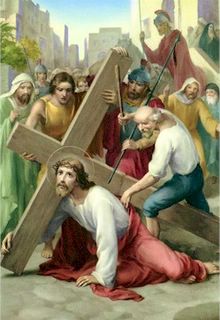
03 Jesus Falls the First Time


05 Simon of Cyrene helps Jesus carry His Cross

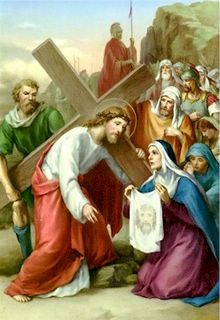
06 Veronica wipes the Face of Jesus


07 Jesus Falls the Second Time

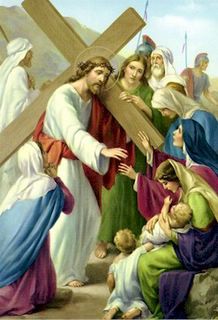
08 The Women of Jerusalem weep over Jesus

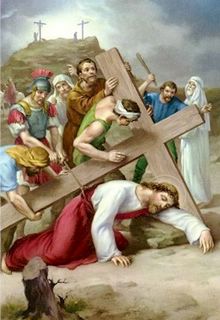
09 Jesus Falls the Third Time


10 Jesus is Stripped of His Garments


11 Jesus is Nailed to the Cross


12 Jesus is raised upon the Cross and Dies

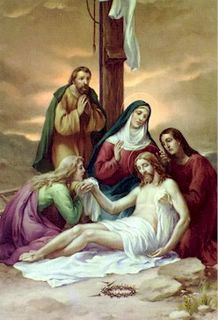
13 Jesus is taken down from the Cross and placed in the arms of His Mother


14- Jesus is laid in the Sepulchre.

Monday, March 28, 2005
Wisdom, The Elements and The Gospels
- from Edmond Wollmann's site:
http://astroconsulting.com/SDSU/wisdom_and_the_gospels.htm
- November 29, 1996
- Kepler College
After having read quite a bit on the philosophical notion of wisdom, as well as the notion put forth in the old testament in Proverbs (where this discussion must begin), it is my firm opinion that the gospels were written with the escalation of consciousness and awareness in mind. I believe that these were meant to culminate as the ultimate expression of wisdom in the Gospel of John that spawns revelation.
According to most philosophical perspectives, wisdom is achieved through questioning—through critical thinking merged with inspired revelation—is what is implied.
(1) Wisdom then from this perspective is questioning everything, so that we are lead to wisdom through this questioning. It is this questioning or action of the seeking of wisdom which has been replaced, where once, as it is represented in the Judaic tradition, wisdom is seen as existing as an archetypal “thing”. However, most students of philosophy would agree that the search for the wisdom is not the same as the practice of it. In other words, either way it is implied that wisdom is a state of being wherein perhaps questioning, perhaps coherency of thought, or an insight from the two has now lead to this state of being. It is this state of being, this evolutionary awareness of the whole, that is the Christ consciousness.
In Proverbs 8, the existence of wisdom as an archetype is laid down;
Does not wisdom call, and does not understanding raise her voice? 2
On the heights, beside the way, at the crossroads she takes a stand...
6 Hear for I will speak noble things, and from my lips will come what is right; 7 for
my mouth will utter truth; wickedness is an abomination to my lips. 8 All the words of my mouth are righteous; there is nothing twisted or crooked in them.
12 I wisdom, live with prudence, and I attain knowledge and discretion.
14 I have good advice and sound wisdom; I have insight I have strength. (2)
It is important that we remember these passages well. Not only because they are reflective of the perspective of the times, but because they are powerfully reflected in manifestation in John’s gospel. This section of the Bible goes on in the following passages to reiterate that wisdom was laid down and created at the beginning of creation. Curiously it is knowledge and discretion that are “attained” through wisdom! Although these aspects are attained, wisdom still seems to be already there, and that these other characteristics are then the product of this state of being in “wisdom”.
Whether we view wisdom as the product of knowledge and discretion, or knowledge and discretion as being the product of wisdom, wisdom still exists as a state of being and receives or exists as the feminine archetypal reference. Meaning; that it is more of an archetypal reference that attracts the being to the state, whereas, the expression of spirit is the masculine force that expresses it. Spirit is the driving force or motivational force of God expressed as masculine that expresses the wisdom of God. This is expressed in Wisdom of Solomon clearly and is even addressed as a female in verse 6:12;
Wisdom is radiant and unfading, and she is easily discerned by those who love her, and is found by those who seek her. She hastens to make herself known to those who desire her.
And again in Corinthians 1:24-30
24 but to those who are called, both Jews and Greeks, Christ the power of God and the wisdom of God....30 He is the source of your life in Christ Jesus, who became for us wisdom from God, and righteousness and sanctification and redemption,
Here it is seen that Christ was embodying wisdom. In essence, that he was the most effective teacher at bringing wisdom—the wisdom that exists eternally—into the world. He, evidently, was the master at the explanation of and expression of this “idea” that exists called wisdom.(3)
That wisdom is the feminine expressed with power as the masculine expression, and is seen again in the Gospel of Matthew 13:54;
He came to his hometown and began to teach the people in their synagogue, so that they were astounded and said, “Where did this man get this wisdom and these deeds of power?”
This wisdom it seems has been expressed over and over as the power that emanates from another world. That it was the will of a creator from another world that was the true will of what “should” be.
yet not what I will but what you will.. Mark 14:36.
And is expressed in the synoptic gospels as the transfiguration Matthew 17:2-5
And he was transfigured before them, and his face shone like the sun, and his garments became white as light. And behold there appeared to them Moses and Elijah, talking with him...when lo, a bright cloud overshadowed them, and a voice from the cloud said, “This is my beloved son, with whom I am well pleased; listen to him.(4)It is this “otherworldliness” that characterized his mission as the Christ.(5) It is this otherworldly orientation that seems to allow him access to the archetype of wisdom as we shall see in John.
So before John, we have;
1) The establishment of wisdom as a feminine archetype that is acted upon through the power of expression.
2) It is expressed as the word, the messenger, the messiah. These are the masculine expressions of the wisdom of God.
3) That from Mark through John we have increasingly mystical expressions or levels of the expression of this idea. In essence, the Christ becomes more and more metaphoric and esoteric as we move through the gospels to John and revelations.
I have been studying the significance of the 3’s and 4’s in all philosophic and actually biological structures as well, and I believe that these choices of 4 gospels and 12 disciples is anything but random.(6) The fact that John is last is no random choice (or manifestation we could say) either in my opinion. The gospel of John synthesizes and acts as the apex of expression of not only the previous gospels, but of the bible in general.
As the expression of wisdom the gospels are written at these different levels for several reasons which are levels in themselves. The first of these is to resonate with all “types” of individuals in these four categories. These four categories are reflected in Astrology represented by the four elements of Fire, Earth, Air and water.
It is apparent that the gospel of Matthew speaks of the birth of Christ with the Magi and the star as a way to establish the identity of Christ in the world (Fire).(7) In Mark, all references such as being in the desert with the wild beasts, establishes Christ and his awakening in the physical or Earthly domain (Earth). In Luke, it begins with the establishment of relationships connected to the Christ (John the Baptist and his birth etc.) and the concepts instilled by angelic beings (8) of what the idea of the Christ was to be (Air).
When we get to Gospel of John, however, we see that he begins with the idea that strongly parallels the wisdom and feminine function and its expression we have been discussing as beingness eternally. John 1;
In the beginning was the Word, and the word was with God, and the word was God. He was in the beginning with God. All things came into being through him, and without him not one thing came into being. What came into being in him was life, and the life was the light of all people. The light shines in the darkness, and the darkness did not overcome it.
Now it appears in John that the empathic knowingness of the “all” that has come before is blended in this gospel in a coherent manner (Water). What do I mean by coherent? It is explained rather well through coherence theory in philosophy and is stated thus that;
“An empirical belief is true if and only if it coheres with a system of other beliefs, which together form a comprehensive account of reality.”(9)
Now of course it can be argued whether the overall thrust of Biblical reference could be considered a comprehensive account of reality, but if we look at the definition closely it is empirical belief that we are discussing. Every system of belief has its own reinforcing logic. Therefore, within each system of belief THE truth is the effect of this system of beliefs and their coherency. It is coherency that the Gospel of John seems to be about. The coherency of blending other world awareness, vision, wisdom and insight in application to this physical world.
And the word became flesh and lived among us, and we have seen his glory as of a fathers only son, full of grace and truth. John 1:14
That this gospel expresses the apex of expression with this empathic theme, is shown in the first sign in verse 2:10 in turning the water to wine;
“Everyone serves the good wine first, and then the inferior wine after the guests have become drunk. But you have kept the good wine until now.
This not only reflects the emotional thematic blending, but, the placement and level of the gospel itself! John establishes his level of coherency in the presentation of the gospel and refers to himself throughout as “the disciple that Jesus loved” to accentuate this emotion. That Christ is married to wisdom is reflected in the statement during the Baptizing (another water reference) in 3:22-28 when in verse 29 he has John the Baptist saying of Christ;
“He who has the bride is the bridegroom. The friend of the bridegroom (meaning himself), who stands and hears him, rejoices greatly at the bridegroom’s voice.
Other water references include; Christ baptizing “more” people than John the Baptist, the Samaritan woman drawing water from the well and his explanation of “living water” that he gives, the washing of the blind man’s eyes in the pool, the royal official who heard of his changing the water into wine’s son being healed as the second sign...so that the momentum of each event flows through John’s gospel into the next with vision through foresight.
In John’s gospel it is made clear that wisdom is made manifest through the life of Christ and that there was no indecision or procrastination in his discernment of it. He also makes clear that everything happens for a reason and the disciples see this—which is not so clearly expressed in the other gospels. He allows us to become aware of the fact that at least from his perspective, Christ knew exactly what he was doing all along and was quite aware of the significance of every event and its meaning, and that relaxing judgment and acknowledging the “real” world, which was actually the other world and this world was the illusion. Is this just great literary ability on the part of John in his expression of the gospel? Was he really there in this interaction and this is the most coherent of the gospels because of his own understanding and wisdom? Or is it as I believe all of the above and the primary reason why he was the “disciple that he loved”?
Although this gospel was written some 100 years after his death, the writing in itself is a superb expression of the wisdom of the probability of other world resource, and its most coherent explanation of a healthy application of those resources. The gospel validates the thrust of the message itself cleverly by using those very resources in the metaphoric as opposed to historic account of the “Good News” (gospel).
Footnotes
1) The Experience of Philosophy, 2nd edition, Daniel Kolack/Raymond Martin, 1993, Wadsworth publishing.
2) Holy Bible, New Revised Standard Version, Oxford University Press, 1989
3) The New Testament Story, David L. Barr, Wadsworth Publishing 1995.
4) This experience parallels the modern psychological experience reported of abduction by "aliens."
5) Living Religions, 2nd edition, Mary Pat Fischer, Prentice- Hall, 1994.
6) Please see, "The Great Pyramids, DNA and The Elements" also by the author.
7) There are many more references I can make for these ideas within each gospel, but for the sake of the focus of this paper only one or two observations are included.
8) Again this experience reflects alien experiences or UFO experiences in the modern era.
9) Philosophy, The Power of Ideas, second edition, Moore and Bruder, Mayfield Publishing, 1993.
Kolak/Martin, The Experience of Philosophy.
Wadsworth Publishing, 1993
Holy Bible, New Revised Standard Edition.
Oxford University Press, 1989
Barr, David L., The New Testament Story.
Wadsworth Publishing, 1995
Fischer, Mary Pat, Living Religions.
Prentice/Hall, 1994
Bruder/Moore, Philosophy, The Power of Ideas.
Mayfield Publishing, 1993
"The kingdom of heaven will not come through expectation -- it is spread across the land but men do not see it." The Gospel of Thomas
© 2001 Altair Publications, SAN 299-5603
Tuesday, March 15, 2005
Women and war – how much do you know?
"Women and war – how much do you know?"
Violence against women in times of armed conflict is carried out by...
(a) Soldiers and the police
(b) Members of armed opposition groups
(c) Peacekeepers
(d) Aid workers
(e) All of the above
Do you know the answer? Take the new Amnesty online quiz to find out.
AMNESTY.CA UPDATES to a friend, send them this link:
http://www.amnesty.ca/updates/latest.html
Home > About Amnesty > History
Peter Benenson - 1921 to 2005
Founder of Amnesty International
The man who lit the fuse of the human rights revolution died last week, having refused all honours and leaving behind him a world changed by the countless protests and petitions he championed.
Peter Benenson, the founder of Amnesty International, was 83.
"The candle burns not for us, but for all those whom we failed to rescue from prison, who were shot on the way to prison, who were tortured, who were kidnapped, who "disappeared". That is what the candle is for."
- Peter Benenson
Recent News Releases
26 February 2005
The man who decided it was time for a change
The man who lit the fuse of the human rights revolution died this week, having refused all honours and leaving behind him a world changed by the countless protests and petitions he championed.
Peter Benenson, the founder of Amnesty International, was 83. He was born into a world without the United Nations. Not a single international human rights treaty was in existence. The Universal Declaration of Human Rights had yet to be written. There wasn’t a single one of today’s major human rights organizations on the political landscape. Civil society was yet to be born.
Inordinately modest and self-effacing, the one-time lawyer who launched Amnesty International in 1961 would never claim credit for the sea-change of the last 40 years. He was offered knighthoods by almost every successive British Prime Minister but he never accepted.
Each Prime Minister who wrote to him received a personal response from Benenson - who typed his own letters until late in life -- in which he would cite the current human rights violations Amnesty was confronting in the UK. He would suggest, without mincing his words, that if the government wished to take account of his work for human rights, what mattered was to redress those abuses.
In comparison with the world into which he was born, Benenson left behind him one changed so fundamentally that it is hard to conceive of the scale of the transformation. Nearly a hundred human rights treaties and other legal instruments are now in force internationally. Over ninety percent of the world’s countries are now party to the most comprehensive of these, the twin international covenants on civil/political and economic/social rights. Almost all of those states have now formally given the right to their citizens to make international complaints.
In addition to the human rights bodies of the United Nations, there are now regional intergovernmental bodies covering up to three-quarters of the world’s nations.
Women’s rights, child rights, minority rights, workers’ rights, the rights of disabled persons - all of these have been codified and strengthened by successive declarations, conventions and acts of national legislation. Torturers have become international outlaws. As we enter the 21st Century, more than half the countries of the world have rejected the death penalty - either by abolishing it altogether or ceasing to carry out executions.
However, the most extraordinary phenomenon - and the one on which Peter Benenson left his indelible mark - is the birth of what has come to be known globally as "civil society". Today there are well over a thousand domestic and regional organizations working to protect human rights. Among them, his brainchild Amnesty International, is one of the best known, with almost 2 million members, subscribers and supporters in more than 64 countries and territories.
But to think of Peter Benenson merely as the founder of one organization (indeed he started several others) is to misread perhaps the single most distinctive political feature of the period from the end of the Second World War to the present: the emergence of organized, non-violent public opinion as an increasingly powerful force in domestic and international politics. Historians may locate its origins in any number of social changes following the war. But there is one event that will incontestably be told and retold in any social history of that period.
It is the story of a man in a bowler hat reading his newspaper on the London underground in late 1960. He reads a small item about two Portuguese students being sentenced to seven years’ imprisonment for raising their glasses in a toast to freedom. He is outraged, decides to go to the Portuguese embassy in London to make a personal protest and then changes his mind. Instead he gets off at Trafalgar Square station and makes his way to the church of St Martin’s-in-the-Fields. He goes in, sits down for three-quarters of an hour, and thinks. In his words,
"I went in to see what could really be done effectively, to mobilize world opinion. It was necessary to think of a larger group which would harness the enthusiasm of people all over the world who were anxious to see a wider respect for human rights."
That man was Peter Benenson, then a barrister in London. When he came outside into the square, he had his idea. Within months, he launched his Appeal for Amnesty with a front page article in The Observer newspaper.
Nothing quite like it had ever been attempted on such a scale before. The response was overwhelming, as if people worldwide were waiting for exactly such a signal. Newspapers in over a dozen countries picked up the appeal. Over a thousand letters poured in within the first six months. And the post-bags of the world’s heads of state changed forever.
Benenson’s idea was so simple, perhaps that’s why he remained so shy of personal publicity throughout his life. Termed "one of the larger lunacies of our time" by one of its critics, a network of letter writers was set up to bombard governments with individual appeals on behalf of prisoners jailed and ill-treated in violation of the Universal Declaration of Human Rights.
In an age of self-aggrandisement, his modesty was almost hard to fathom. He never went forward to receive the numerous accolades showered upon Amnesty, known universally by its candle in barbed wire. His mind was always fixed on what had not been accomplished and the countless victims still to be rescued.
"The candle burns not for us," he declared, "but for all those whom we failed to rescue from prison, who were shot on the way to prison, who were tortured, who were kidnapped, who ‘disappeared’. That is what the candle is for."
In later years, as Amnesty’s impact grew exponentially and went on to harness the power of the international news media, other groups began to adopt and adapt its methods in support of their causes. The extraordinary impact of the environmental movement twenty years later, the women’s rights movement and a host of other single-issue and coalition groups, working in their own countries or across national boundaries, can often be traced to the early examination they made of the methods Benenson’s organization was using.
Today we take the power of charities, voluntary groups and people’s campaigns for granted. But before that day in Trafalgar Square - the day on which a single newspaper reader decided it was time for a change - that power had yet to shake the world.
Nothing has ever been quite the same since. As he said in 1961, lighting the first Amnesty candle, "I’m reminded of the words of a 16th century man sentenced to death by burning: We have today lit such a candle as shall never be put out."
Resource News Archives Search
Thursday, February 24, 2005
Full Moon in Virgo ~ Wednesday February 23, 2005
23:54 EST
Sun at 5.41 Pisces
Virgo Full Moon Reflections: Further Adventures with Water
by Jean Hinson Lall
Regular readers of this column may recall that in our Baltimore home my husband and I occasionally have very engrossing adventures with water (basement flooding, leaky pipes and roofs, back-yard drainage issues, even weird hemorrhages in our cars). Last month, returning to Canterbury to resume my studies, I thought I might, as a side benefit of the trip, get a break from all that. After a bit of searching I found a great place to live near the campus, but when I came to see it the owner of the house explained that the ceilings in two rooms would have to be taken down and replaced in the near future as a result of a leaky roof on one side and a broken pipe on the other. While I was talking with her, in fact, a new leak was discovered in the dining room ceiling, producing a nasty puddle on the parquet floor. I had to laugh; there was no evading my drippy destiny even by relocating across the ocean!
Repairs are proceeding, however, and my own room is snug and dry. I’ve settled in and begun to get engrossed in my research. One day last week, after reading some particularly stimulating material, I lay down for a short nap and dreamt that water was pouring in through the illuminated light fixture above my bed. I ran downstairs to look for a dishpan or bucket to catch the water.
When I woke up I laughed again. As the old saying goes, "when it rains, it pours": when something significant happens to us on one level, often it is working on other levels as well. While I keep on encountering unexpected water events in my physical existence, the dream hints at an influx of a more subtle kind of water.
It would be much too tedious and disheartening to take all these leaks personally, so I referred them to the planets. In the Aquarius New Moon column we looked at the image of the Water-Bearer who not only irrigates the land but pours out the "living waters" of spiritual renewal. Now the Sun has moved into Pisces, and at the Full Moon will be just a day away from an exact conjunction with Uranus, the planet whose name means "Heaven." While, as we noted last time, Neptune sojourns in the rarefied air of Aquarius where Uranus is co-ruler, Uranus is making a reciprocal journey through Neptune’s watery realm of Pisces, making for a "mutual reception" between these two slow-moving outer planets. It does seem a suitable time to reflect further on the waters and their relationship to "Heaven."
On the first day of creation, according to the Book of Genesis, when the earth was as yet formless and void, God’s Spirit moved upon the face of the waters, and then God created light and separated the light from the darkness, and Day from Night. On the second day, ". . .God said, Let there be a firmament in the midst of the waters, and let it divide the waters from the waters. And God made the firmament, and divided the waters which were under the firmament from the waters which were above the firmament: and it was so. And God called the firmament Heaven."
Heaven, according to this version of events, is designed as a support structure, a strong framework or vault that is needed to divide the upper waters from the lower waters. In this, as in creation narratives generally, a good deal of the creator’s job involves separating and dividing things, creating distinctions and polarities. "Waters Above/Waters Below" is an interesting polarity, not so familiar and self-evident as pairs like "Earth and Heaven," "Light and Darkness," "Day and Night," "Water and Dry Land" or "Male and Female." We have to stop and think why it would be important in the divine plan to separate the waters, which appear to be the first matter of creation, in this definitive way.
One thing this separation accomplishes is to create a space for reflection and for metaphor. We are able to experience our lives consciously precisely because of this division, through the resonance between events on different levels. Imagination and thought dance in the space between, drawing down water from above – poetry, mystical vision, music or inspired ideas -- to meet the humble water of daily existence. Spiritual water becomes more accessible to us and more potent through its resemblance to physical water, while physical water and all the labour of dealing with it (rivers and seas, navigation, flood control, irrigation, bathing, household washing, plumbing repairs) are lifted up and infused with meaning when linked to the higher waters through metaphor and symbol.
The Moon now is opposite Sun and Uranus in One thing this separation accomplishes is to create a space for reflection and for metaphor. We are able to experience our lives consciously precisely because of this division, through the resonance between events on different levels. Imagination and thought dance in the space between, drawing down water from above – poetry, mystical vision, music or inspired ideas -- to meet the humble water of daily existence. Spiritual water becomes more accessible to us and more potent through its resemblance to physical water, while physical water and all the labour of dealing with it (rivers and seas, navigation, flood control, irrigation, bathing, household washing, plumbing repairs) are lifted up and infused with meaning when linked to the higher waters through metaphor and symbol.
The Moon now is opposite Sun and Uranus in Virgo, the mutable Earth sign that complements Pisces. Virgo is stereotyped as the practical housewife and caregiver who cleans up after everybody, as well as the teacher, the student, the nurse and the researcher or technician busily at work. (She’s definitely the one who rushes downstairs in search of a bucket to catch the water pouring in through the light fixture.) But she is also the Cosmic Mother who gives birth to the divine. Spiritually, she is that in us which is well-defined, disciplined and bounded yet exquisitely receptive, able to receive and contain the fertile water of Pisces. Just as Pisces (depicted as two fishes swimming in opposite directions) has its dual Waters, Virgo meets them with an upper and a lower Earth, uniting in herself the practical and the sublime.
The conjunction of Sun and Uranus in Pisces could be a potent time for the descent of new ideas or images. As they meet and look across at the Full Moon, have your buckets ready to catch what may flow from above.
© 2005 Jean Hinson LallAll rights reserved
Look for the Pisces New Moonon March 10, 2005. , the mutable Earth sign that complements Pisces. Virgo is stereotyped as the practical housewife and caregiver who cleans up after everybody, as well as the teacher, the student, the nurse and the researcher or technician busily at work. (She’s definitely the one who rushes downstairs in search of a bucket to catch the water pouring in through the light fixture.) But she is also the Cosmic Mother who gives birth to the divine. Spiritually, she is that in us which is well-defined, disciplined and bounded yet exquisitely receptive, able to receive and contain the fertile water of Pisces. Just as Pisces (depicted as two fishes swimming in opposite directions) has its dual Waters, Virgo meets them with an upper and a lower Earth, uniting in herself the practical and the sublime.
The conjunction of Sun and Uranus in Pisces could be a potent time for the descent of new ideas or images. As they meet and look across at the Full Moon, have your buckets ready to catch what may flow from above.
© 2005 Jean Hinson LallAll rights reserved
Look for the Pisces New Moon
Sunday, February 13, 2005
Claudia Fernety ~ artist

"To a Safer Place"

Claudia Fernety, Online Gallery
I recommend regular look-see's of her web-site ~ Claudia Fernety has three gallery sites filled already...and counting:
Please note the "Copyright" embedding in all the images I uploaded. I might have used thumbnails without the word allowing you to download a clean sample but that would be cheating, not to mention illegal. I uploaded her paintings to spread the good word about her mission and her talent:
© Claudia Fernety. All rights reserved.
Images may not be reproduced without written permission.
For more information, send email to address below.
Claudia Fernety, Artist
If you would like to know more about Claudia Fernety's work in the arts and in her community, send her an email at: claudia@claudiafernety.com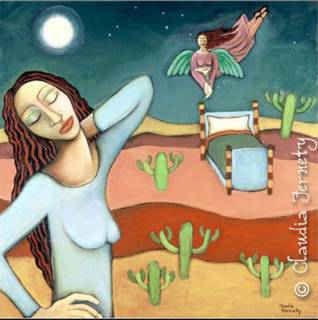
"Little Rose"
Claudia Fernety's Statement
 I have always had a desire to create, and when I was a child, I thought it would be my life's work. At one point, I pursued the theater and later, music. But I lacked direction, and so I nurtured my other interest, which was sociology, and became a social worker.
I have always had a desire to create, and when I was a child, I thought it would be my life's work. At one point, I pursued the theater and later, music. But I lacked direction, and so I nurtured my other interest, which was sociology, and became a social worker.
I counseled battered women and later worked with the homeless/mentally ill. I was dedicated to my work, but not fulfilled. I always joked that I was good for social work, but social work wasn't particularly good for me.
In 1998, I had the chance to travel to Italy (the Etruscan town of Cortona) with my husband, and everything changed. I quit my social work job and for those six months abroad, was determined to teach myself to paint. I visited Florence and Rome to study the paintings of the Renaissance period, and painted constantly (we had no TV!). Despite that what I painted was pretty awful, I found I loved painting nonetheless, and eventually, I did get better.These days, I am passionate about painting and exhibiting my work. I live in San Diego with my husband Marty Sereno and our cat, Bella. When I'm not painting, I volunteer my time to Peace and Justice work.
- Small Image Show, Gallery 21, San Diego, CA. 2/00.
- Mural, The U.N. Assoc., Balboa Park, San Diego, "Esperanza por la Paz", 1999.
- Mural, The UN Assoc., Balboa Park, San Diego,
"The Children's Mural: Peace Through Education", 10/00. (Featured in the Winter 2001 issue of the L.A. Mural Conservancy's journal on new murals of California). - Gargoyle Gallery, San Diego, Two-person show, 11/00.
- ArtWalk, The Refrigerator Project, San Diego, 4/01.
- A Hunger Artist Gallery, New Mexico,"Psychologically Charged," 8/01.
- San Diego Children's Museum, Solo show,"Faces of Humanity," 10/01 through 1/02.
- Self-Help Gallery, East Los Angeles,Recent Work, 12/02 through 5/02.
- Ray Street - Gallery 999, Solo show,"Recent Work," 2/02 through 3/02.
- Sushi Gallery - Group Show"Life Stage", July 26-28, 2002.
- World Beat Center, Activist San Diego Exhibit, July 12, 2003.
- Galleri Urbane, Silver City, New Mexico, July 25-Aug 25, 2003, Group Show.
- La Voz Alta, San Diego, Aug. 30 - Oct. 15. 2003, "Arabs Anonymous", group show.
- Espresso Mi Cultura, Hollywood, CA.Group Show, Nov - Dec 2003.
- Self-help Gallery, East Los Angeles, "Mujeres de Juarez" Group Show April 13 - May 9, 2004.
- Galleri Urbane, Silver City, New Mexico,July 30-Aug 21, 2004, Women's Show.
- Hispanic Museum of Nevada , "Mujeres de Juarez," Group Show, Aug. 12 - Sep. 15, 2004
ARK Playhouse, San Diego, "Parallel Visions", Group Show, in conjunction with "Remains," a play centered on the Israeli-Palestinian conflict,Sept.9 - Oct. 3, 2004.
Flyer for Exhibit & the play ''remains'' 
 Reception for the Artists
Reception for the Artists
Group Exhibit in conjunction with the play, "remains" held September 9th, 2004
...a larger view of the flyer...
Play Summary: When an American college student is found dead in Tel-Aviv,her mother uses her journal to piece together her daughter's journey. A play about a mother, a daughter and their journey through the Israeli-Palestinian conflict, loosely based on the Rachel Corey story.
Most performances followed by a discussion.
Claudia Fernety, Education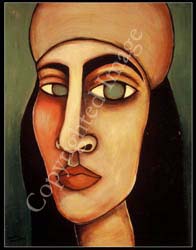
"Self-Portrait"
- University of California, San Diego: B.A., Sociology, 1990.
- San Diego State University: M.A., Social Work, 1992.
- Art Education: Self-taught



